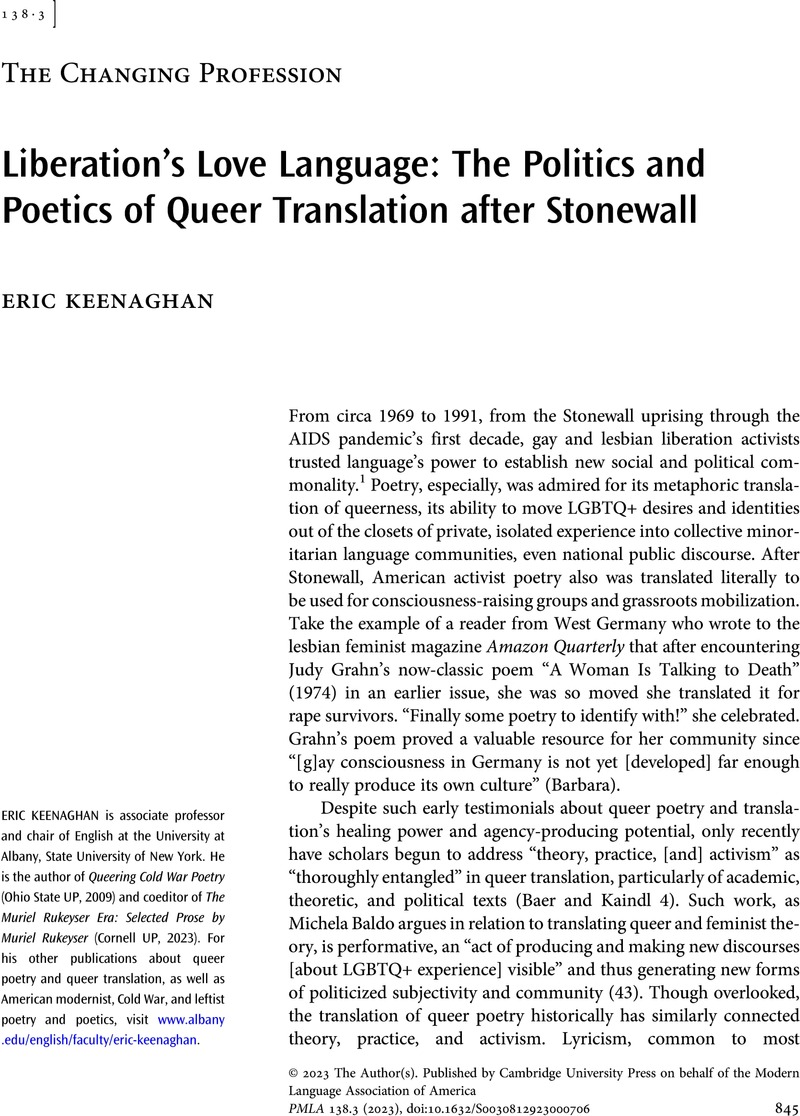No CrossRef data available.
Article contents
Liberation's Love Language: The Politics and Poetics of Queer Translation after Stonewall
Published online by Cambridge University Press: 12 September 2023
Abstract
An abstract is not available for this content so a preview has been provided. Please use the Get access link above for information on how to access this content.

- Type
- The Changing Profession
- Information
- Copyright
- Copyright © 2023 The Author(s). Published by Cambridge University Press on behalf of the Modern Language Association of America
References
Works Cited
Baer, Brian James, and Kaindl, Klaus. “Introduction: Queering Translation.” Queering Translation, Translating the Queer: Theory, Practice, Activism, edited by Baer, and Kaindl, , Routledge, 2018, pp. 1–10.Google Scholar
Baldo, Michela. “Activist Translation, Alliances, and Performativity: Translating Judith Butler's Notes toward a Performative Theory of Assembly into Italian.” The Routledge Handbook of Translation and Activism, edited by Rebecca Ruth Gould and Kayvan Tahmasebian, Routledge, 2020, pp. 30–48.CrossRefGoogle Scholar
Barbara. Letter to the editor. Amazon Quarterly, vol. 2, no. 4, July 1974, p. 70. Independent Voices, www.jstor.org/stable/community.28032327?ab_segments=0%2Fbasic_search_gsv2%2Fcontrol&refreqid=fastly-default%3Ae071e9ff6e243acfe5008c29bbb9be2c&seq=72.Google Scholar
Bronski, Michael. “Zines from a Revolution.” Poetry Foundation, 24 June 2019, www.poetryfoundation.org/articles/150351/zines-from-a-revolution.Google Scholar
Bush, George. “Andalusian Boy Love.” Gay Sunshine, nos. 26–27, winter 1975–76, p. 30. Gale Archives of Sexuality and Gender, link-gale-com.libproxy.albany.edu/apps/doc/UEVURU963863317/AHSI?u=albanyu&sid=bookmark-AHSI&xid=cbea80d1.Google Scholar
Catullus. The Poems of Catullus. Translated by Martin, Charles, Johns Hopkins UP, 1990. Originally published by Abattoir Editions, 1979.Google Scholar
Cernuda, Luis. The Young Sailor and Other Poems. Translated by Lipinski, Rick, Gay Sunshine Press, 1986.Google Scholar
Genet, Jean. The Complete Poems of Jean Genet. Translated by Fisher, David et al., ManRoot, no. 12, 1981. Independent Voices, www.jstor.org/stable/community.28040411.Google Scholar
Genet, Jean. Interview with Nigel Williams. 1985. The Declared Enemy: Texts and Interviews, edited by Dichy, Albert and translated by Fort, Jeff, Stanford UP, 2004, pp. 257–65.Google Scholar
Grahn, Judy. Eruptions of Inanna: Justice, Gender, and Erotic Power. Nightboat Books, 2021.Google Scholar
Keenaghan, Eric. “Jack Spicer's Pricks and Cocksuckers: Translating Homosexuality into Visibility.” The Translator, vol. 4, no. 2, 1998, pp. 273–94.CrossRefGoogle Scholar
Keenaghan, Eric. “Recognizing Forbidden Pleasures: Translating the Tension between Reality and Desire in Luis Cernuda's Poetry.” Translation Studies, vol. 4, no. 2, 2011, pp. 149–65.CrossRefGoogle Scholar
Leyland, Winston, editor. Gay Roots—Twenty Years of Gay Sunshine: An Anthology of Gay History, Sex, Politics, and Culture. Gay Sunshine Press, 1991.Google Scholar
Mariah, Paul. “My Mother Genet.” This Light Will Spread: Selected Poems, 1960–1975, ManRoot, 1978, p. 30.Google Scholar
Norton, Rictor. “The Homosexual Literary Tradition: Course Outline and Objectives.” College English, vol. 35, no. 6, Mar. 1974, pp. 674+.CrossRefGoogle Scholar
Santaemilia, José. “Sexuality and Translation as Intimate Partners? Questions for a Common Exploration.” Queering Translation, Translating the Queer: Theory, Practice, Activism, edited by Baer, Brian James and Kaindl, Klaus, Routledge, 2017, pp. 11–25.CrossRefGoogle Scholar
Young, Allen. “Out of the Closets, into the Streets.” Out of the Closets: Voices of Gay Liberation, edited by Young, Karla Jay, , 20th anniversary ed., New York UP, 1992, pp. 6–31.Google Scholar


